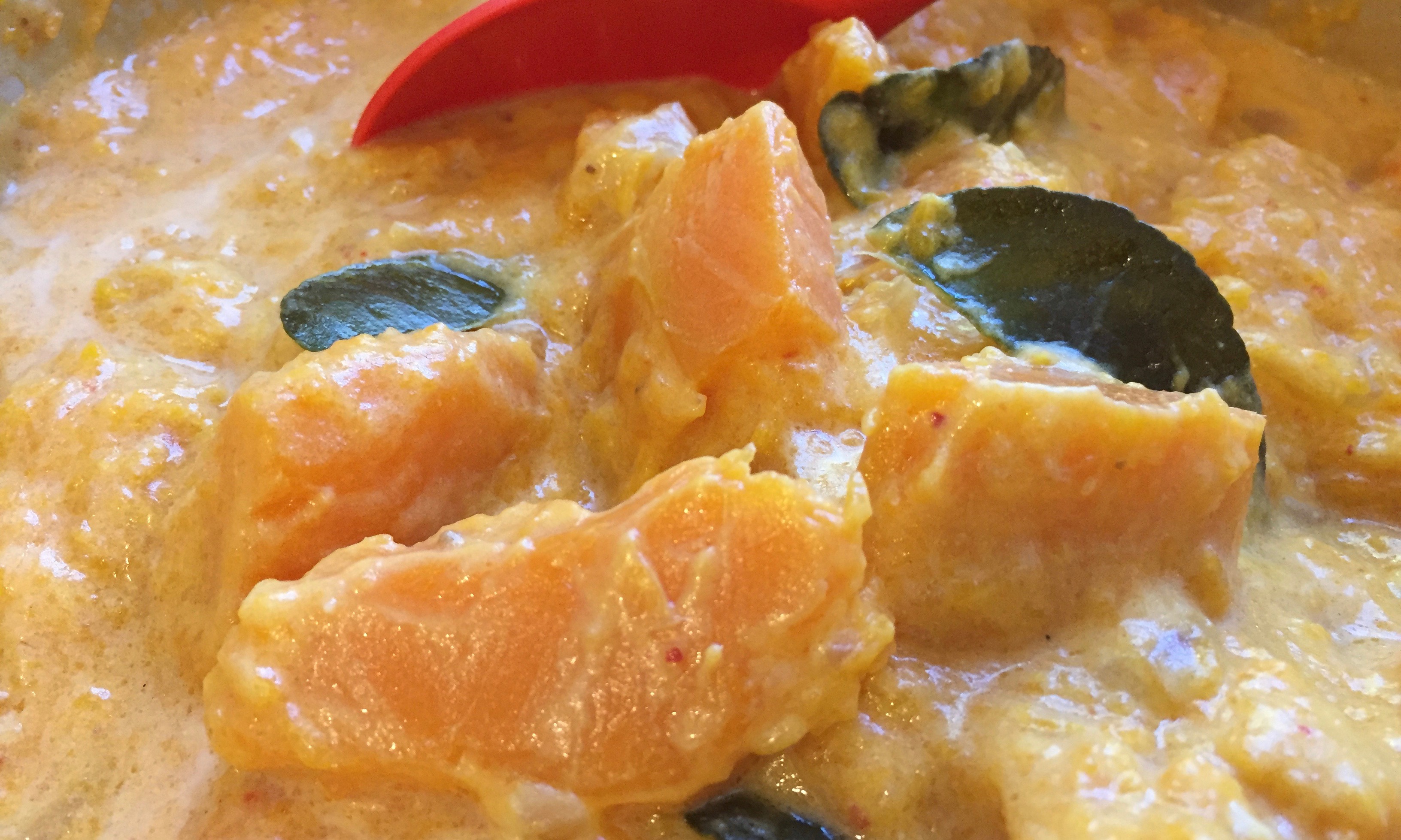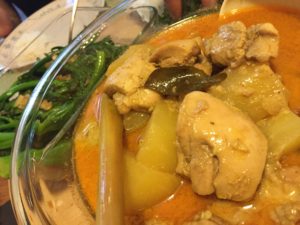
Both my kids are home, Russ from a long trip away. Chicken curry is how I welcome them back. I learned how to make curry from Popo, my grandmother, so it is one of those things I will pass down from generation to generation.
This is a very standard way of cooking curry in Singapore. And I have tasted this same curry in the homes of my Malay, Indian, Eurasian and Peranakan neighbors.
Peranakan are Chinese in Singapore and Malaysia who intermarried with Malay and have blended the two cultures. Also called Straits-born Chinese, the men are called Babas and the ladies Nonyas. Their way of dressing (both men and women wore sarongs), the language spoken (using English, Hokkien or Teochew with Malay in their lingua franca) and their fabulous food define this unique culture group. Nonya or Peranakan food marries the cuisine of both cultures. In each dish, it is both Chinese and Malay. The cooking styles are adopted from each rich culture and the ingredients are traditional Chinese and also Malay, making the most of the spices and ingredients that is so abundant in the region. Soy sauce, soy bean pastes, black fungus, noodles are in play with turmeric, galangal, nutmeg, lemongrass, curry leaves, tamarind, candlenuts, belachan, chili and coconut milk. The way we cook this curry is typical of how Peranakans would cook.
Where they lived in the tin-mining district of Perak in Malaya in the early 1900s, my grandmother and great-grandmother were also greatly influenced by Malay styles of cooking. Popo loved her curries, belachan and chili.
Following Popo’s tradition I usually make more than what we can eat in one meal because leftover curry is super good the next morning. Popo used to make a humongous pot whenever we went to beach bungalow resorts in Changi, Singapore. There’s no better breakfast than dipping good bread into reheated curry with the thought of playing on the beach after that!
Cooking curry is just braising
Although this is so completely different in taste from any Chinese braised chicken, Chicken Curry is still only braised chicken. It follows the same basic braise process: marinate chicken, brown aromatics, brown chicken, add seasoning and liquid and simmer. In cooking curry, the aromatics include a curry paste. Coconut milk is added in the simmer.
The ingredient that makes Singaporean Chicken Curry distinct is the kind of curry base or paste used. The trick is to fry the curry paste into a fragrant aromatic base, browning the chicken in it and adding coconut milk when the flavor is sealed. There are a few ways to make this curry paste.
The easiest, basic way of making curry paste
The simplest way is to use (dried) curry powder and blend it into curry paste. The recipe below uses this paste. All it involves is mixing two tablespoons of curry powder with the same amount of water, as shown below. Today you can find curry powder in most stores, not only in Asian supermarkets. We Singaporeans are fussy about our blend of curry so many of us just bring them from overseas. My favorite brand is Baba’s which is available from Amazon.
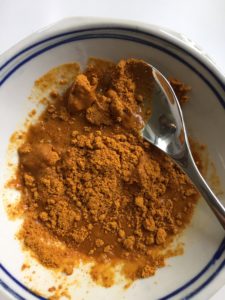
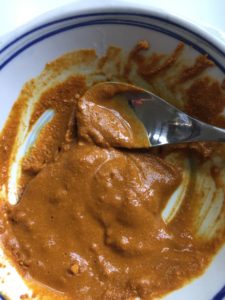
Traditional way of making curry paste
Nonya cooks, and we too, make our own pastes. We will tumbuk or pound our own rempah, which is a paste of shallots, garlic, and other fresh ingredients. See picture below. In curry, these may include fresh chili, ginger, galangal, turmeric and candlenuts. Ground powder like coriander, cumin pepper and cinnamon may also be added. Fresh curry pastes like these are sold in every wet market in Singapore and most of us have our stall to go to for the blend we like best. The seller will ask you what you are cooking and will combine different grounded fresh spices, depending on whether you are cooking meat, chicken, fish or vegetable curry.
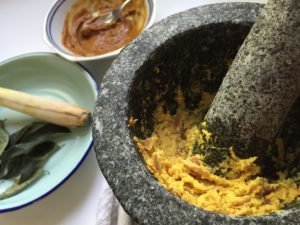
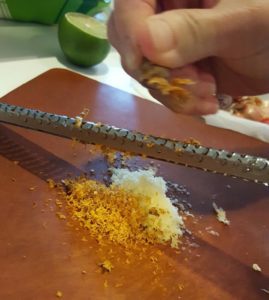
Your options
If you have a mortar and pestle, try pounding your own rempah. It adds richness to curry. I usually make this simple rempah and then use it in combination with curry powder. My basic rempah combines garlic, shallots, turmeric, galangal with candlenuts. Galangal and turmeric are sold in Thai supermarkets and I’ve also found them in Korean supermarts. Candlenut is optional; it may be substituted with macadamian nuts. For exact portions for this basic rempah, see NOTES below.
Instead of pounding, you can also grate garlic, shallot, turmeric and galangal finely. You can also use a blender. Add a little oil to blend the roots. Candlenuts, however, don’t blend well and remain in little hard pieces.
Singapore chicken curry is tastiest when you use a whole chicken, chopped into pieces leaving bone in. In the U.S., boneless chicken is preferred so this recipe uses boneless thigh, which I think results in more tender meat than breast.
In this recipe, I start the frying process in a non-stick pan and transfer it to a pot for braising. This reduces the risk of burning the paste. You can also start and cook everything in a pot.
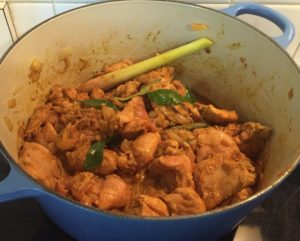
Singaporean Curry Chicken
Serves 4
Preparation time: 20 minutes
Cooking time: 1 hour
4 pounds boneless, skinless chicken thigh, each thigh cut into 3 or 4 pieces
3 tablespoons curry powder
1 tablespoon soy sauce
2 tablespoons water for curry paste
1 stalk lemongrass
4 tablespoons oil
¾ cup chopped onion
1 stick cinnamon
3 or 4 stalks curry leaves, leaves removed and stalks discarded
¾ cup coconut milk
1 cup water
1 pound potatoes, peeled and cut into large bite size pieces
Salt
Put chicken in a large bowl. Sprinkle 2 teaspoons curry powder, soy sauce and 1 teaspoon salt over chicken and rub well into chicken. Leave to marinate for about 30 minutes.
In a small bowl, blend the remaining curry powder with 2 tablespoons water to make a paste. Trim lemongrass, leaving only 3-4 inch base of stalk. Peel off dry pieces and slit stalk lengthwise to release oil. Have all ingredients ready and set aside.
In a large, non-stick frying pan, heat half the oil over high heat. Add onion and fry for about 30 seconds. Turn heat down to low and keep frying onion to prevent burning until heat is reduced. Cover pan and allow the onion to cook over low heat, stirring periodically, for about 5-10 minutes. Don’t hurry this process as this is an important part in making a good curry sauce.
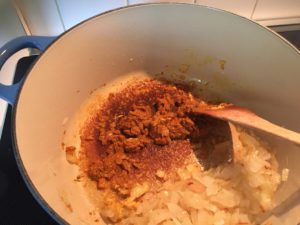 Frying the rempah: When onion softens, push onions aside in pan. To an empty spot in pan, add rest of oil. Raise heat to medium-high. When oil is hot, add curry paste. Fry paste until oil is well absorbed, about 1-2 minutes. Lower heat to medium to prevent burning. When paste reaches a deeper color, mix onion to paste and fry to combine.
Frying the rempah: When onion softens, push onions aside in pan. To an empty spot in pan, add rest of oil. Raise heat to medium-high. When oil is hot, add curry paste. Fry paste until oil is well absorbed, about 1-2 minutes. Lower heat to medium to prevent burning. When paste reaches a deeper color, mix onion to paste and fry to combine.
Add chicken. Mix the onion-curry paste well with the chicken, and fry the chicken until the pieces are slightly browned, about 1 minute. Reduce heat to low and add a little water—no more than ¼ cup–if necessary, to prevent burning. Add ½ teaspoon salt, stir well to mix with spices and chicken. Add cinnamon, curry leaves and lemongrass. Cover and cook for about 5-10 minutes on low heat, allowing juices to be drawn out from chicken.
Bring the heat up. Add half the coconut milk and mix well. Transfer chicken and other ingredients into a pot.
Braising chicken: Add potatoes and the rest of water to cover potatoes. Bring sauce to a boil. Then lower heat, cover and braise on low for about 20-25 minutes or until potato is cooked. Add rest of the coconut milk, bring to a boil for about 30 seconds. Turn off heat. Adjust taste, adding salt, if necessary.
Notes
-Frying the chicken in the rempah seals in the curry flavor. This is a tricky part of cooking curry. If the heat is too high, it may burn the curry paste if you are not using a non-stick pan. To prevent burning, fry chicken quickly and then lower the heat. Sprinkle about ¼ cup of water, if it looks like it is getting too dry. At this point don’t add too much water and spoil the browning. Cover the pan and keep cooking chicken on low heat. The chicken will exude juices.
–If you wish to have a curry with more sauce—the preferred Chinese curry—add another ½ cup water or coconut milk only later, during braising when potato is added.
A curry with more sauce is great dipped with bread. You can also put noodles in curry. The curry is also sometimes cooked with less gravy.
–Canned coconut milk usually comes in 14 fluid ounce (400 ml) sizes. Use half a can for this recipe and freeze remaining in a plastic tub for later use. There are no exact measures for how much coconut milk you want to use. You can also use a whole can, which will result in what we call a lemak curry, which is a curry that is rich in coconut flavor.
–Some cooks deep fry the potato pieces before adding to chicken. It tastes very good but more work. When cooking the potato in the curry, push the pieces into the sauce so the potato cooks better.
Making basic rempah
1 large shallot, about ¼ cup, roughly sliced
3 cloves garlic
1 thumb-size turmeric, peeled
1 thick slice galangal, peeled
4 candlenuts
In a mortar first pound shallots with garlic until well mashed. Scoop out and set aside. Pound turmeric with galangal and when they are well grounded scoop out and set aside. Pound candlenuts into a smooth paste. Then return all the other ingredients and pound and grind to combine. Turn rempah periodically with a metal spoon so contents are evenly grounded.
Use this rempah in combination with curry paste.
To make your own curry powder: Click here.
BANQUET TIPS
Cooking ahead for parties
Curry always tastes better the second day. This makes it a perfect dish to prepare for parties. Make curry a day ahead if you have other dishes to cook on day of party.
If you plan to use the curry a day later, stop the braising process after 15-20 minutes when chicken is just cooked and potato is still firm. Remember that after you turn off the heat, the meat and potato will continue to cook. Cool curry and refrigerate.
To reheat the curry, add ¼-½ cup of water and bring it to boil on medium heat, stirring it gently so as not to mash up potato. Don’t reheat leftover curry on high heat; the sauce at the bottom of the pan will burn.
Glossary of Ingredients
Click here for more on:
Candlenuts
Cinnamon
Coconut milk
Curry leaves
Curry powder
Galangal
Lemongrass
Soy sauce
Turmeric


